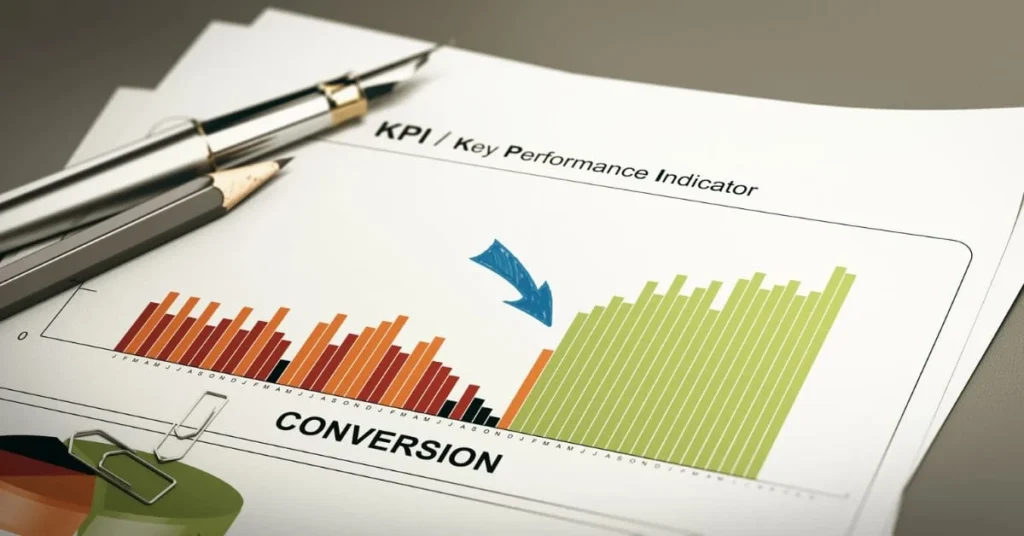Heard about this? Affiliate marketing is quickly becoming one of the most popular ways to earn passive income online. In fact, did you know that affiliate marketing spending in the U.S. is expected to reach $8.2 billion by 2025? That’s right — there’s serious potential here for anyone willing to put in the effort.
But here’s the kicker: not all affiliate websites are created equal. Some manage to rake in profits effortlessly, while others barely make a sale. The difference often boils down to one thing: how well the website is designed to convert visitors into buyers.
So, what’s the secret sauce? Today, we’re going to explore exactly how to build a high-converting affiliate website from scratch. Whether you’re just starting out or looking to optimize an existing site, this guide will walk you through every step you need to take to start building your affiliate empire.
Understanding the Basics of Affiliate Marketing

Before we dive into the nitty-gritty of building your website, let’s start with the basics. What exactly is affiliate marketing, and how does it work? At its core, affiliate marketing is a type of performance-based marketing where a business rewards affiliates (that’s you) for driving traffic or sales through the affiliate’s marketing efforts. In simpler terms, you earn a commission for promoting someone else’s product or service.
How Does Affiliate Marketing Work?
Imagine this: You’re running a blog about tech gadgets. You write an engaging review about a new smartphone, and in that review, you include a special link to the product. This link is your affiliate link. When one of your readers clicks on it and buys the smartphone, you earn a commission. Easy, right? The beauty of affiliate marketing is that it allows you to make money while providing value to your audience.
Types of Affiliate Programs
There are several types of affiliate programs you can join, each with its own structure for paying commissions:
- Pay-Per-Sale (PPS): This is the most common type of affiliate program. You earn a commission every time someone makes a purchase through your affiliate link. This model is great for products with higher price points or recurring subscription services.
- Pay-Per-Click (PPC): In this model, you earn money each time someone clicks on your affiliate link, regardless of whether they make a purchase. PPC programs usually offer lower commissions, but they can add up if you generate a lot of clicks.
- Pay-Per-Lead (PPL): With PPL programs, you get paid when someone signs up or takes a specific action (like filling out a form) through your affiliate link. This model is popular in industries like insurance or real estate.
Each of these programs has its pros and cons, depending on your niche and audience. Choosing the right type of affiliate program is crucial for maximizing your earnings. Now that you have a solid understanding of affiliate marketing basics, it’s time to move on to the next step: picking the perfect niche for your website.
Choosing the Right Niche
Choosing the right niche is like picking the foundation for your house — it’s a critical decision that impacts the success of your affiliate marketing website. A well-chosen niche not only aligns with your interests and expertise but also has the potential to attract a dedicated audience who are ready to buy what you’re promoting.

Why Is Picking the Right Niche So Important?
First things first, let’s talk about why the right niche is so important. When you choose a niche that you’re passionate about or knowledgeable in, creating content becomes a breeze. Plus, your enthusiasm and expertise will shine through, helping you build trust with your audience. And in affiliate marketing, trust is everything.
On the flip side, picking a niche that’s too broad or too competitive can make it hard to stand out. That’s why it’s crucial to find a balance — a niche that’s specific enough to target a particular audience but broad enough to have plenty of affiliate products to promote.
How to Choose a Profitable Niche
So, how do you choose a profitable niche? Here are some steps to guide you:
- Assess Your Interests and Expertise: Start by making a list of topics you’re passionate about or have experience in. Are you a fitness enthusiast? Do you love gardening? Maybe you’re a tech geek who’s always up-to-date with the latest gadgets. Choose something that you enjoy and can see yourself creating content about consistently.
- Research Market Demand: It’s not enough to just be interested in a topic; you also need to make sure there’s a market for it. Use tools like Google Trends, keyword research tools (like Ahrefs or SEMrush), and online forums to gauge interest in your potential niches. Look for topics that have a steady level of interest over time and aren’t just fleeting trends.
- Analyze Competition: While a little competition is good (it indicates a profitable market), too much competition can make it hard for you to stand out. Check out other affiliate websites in your potential niche. If you find that the top spots are dominated by big players, it might be worth considering a more niche angle.
- Consider Monetization Potential: Finally, think about how you can monetize your niche. Are there enough affiliate programs available? Are the commission rates attractive? Are there other monetization methods you can use, like selling your own products or offering services? Choosing a niche with multiple revenue streams can help you maximize your earnings.
Tools for Niche Research
Here are a few tools to help you research and validate your niche:
- Google Trends: Helps you understand the popularity of a niche over time.
- Ahrefs/SEMrush: Great for keyword research and understanding what’s already out there.
- Amazon Best Sellers: Provides insights into what products are selling well and can help you identify trends in different categories.
- Reddit/Quora: These platforms are goldmines for understanding what real people are interested in and what questions they have.
Choosing the right niche takes a bit of time and research, but it’s an investment that will pay off in the long run. Once you’ve nailed down your niche, you’re ready to move on to the next step: selecting the best affiliate programs to join.
Selecting an Affiliate Program
Now that you’ve chosen your niche, it’s time to find the best affiliate programs that align with your topic and audience. Picking the right affiliate program is like choosing the right partners in business — it’s essential for ensuring your efforts are well-rewarded and your audience gets quality recommendations.

What Makes a Good Affiliate Program?
Not all affiliate programs are created equal. A good affiliate program should offer a fair commission, high-quality products or services, and provide support and resources for its affiliates. Here are some factors to consider when choosing an affiliate program:
- Commission Rates: This is a biggie. Different programs offer different commission rates, usually ranging from 5% to 50% or even more for digital products. Look for programs that offer a fair commission structure that aligns with the product’s value and your promotional efforts. Higher isn’t always better, though — make sure the program has a good reputation and pays on time.
- Product Relevance: Ensure the products or services align with your niche and audience’s interests. If you’re running a tech blog, promoting beauty products might not make sense. Your audience is more likely to trust your recommendations if they’re directly related to your niche.
- Cookie Duration: The cookie duration determines how long after a visitor clicks your affiliate link you still earn a commission if they make a purchase. Some programs offer 24-hour cookies, while others might offer 30 days or even 90 days. A longer cookie duration can increase your chances of earning a commission, especially if the customer takes time to decide.
- Program Reputation and Support: It’s important to work with affiliate programs that have a good reputation. Look for programs that are known for their reliability, prompt payments, and good customer service. Some programs also offer affiliate support in the form of training, marketing materials, and a dedicated affiliate manager.
- Payout Threshold and Frequency: Check the minimum payout amount and how frequently payments are made. Some programs might only pay out once you’ve reached a certain threshold, like $50 or $100, and they might pay monthly or bi-weekly.
Popular Affiliate Networks and Programs
To get you started, here are a few popular affiliate networks and programs you might consider:
- Amazon Associates: One of the most popular affiliate programs, Amazon Associates allows you to promote millions of products available on Amazon. It’s great for beginners because it’s easy to use and has a huge selection of products. However, commission rates can be relatively low compared to other programs.
- ShareASale: This network has been around for years and offers a wide variety of merchants and products. It’s user-friendly and provides detailed reports to help you track your performance.
- Commission Junction (CJ Affiliate): A large and well-established network that offers a diverse range of products and services. It’s known for its reliable payments and robust tracking tools.
- ClickBank: Ideal for promoting digital products like eBooks, courses, and software. ClickBank offers high commission rates, sometimes up to 75%, and has a reputation for being affiliate-friendly.
- Rakuten Advertising: Another large network with a broad range of merchants. Rakuten is known for its high-quality partnerships and strong affiliate support.
How to Choose the Best Programs for Your Niche
Choosing the best affiliate program for your niche involves a mix of research and testing. Start by making a list of potential programs and evaluating them based on the factors above. Join a few programs and test which ones perform best for your audience. Remember, the key is to recommend products that provide genuine value to your readers — this will help build trust and lead to higher conversion rates over time.
With your niche chosen and affiliate programs selected, it’s time to get your website up and running. Next, we’ll dive into the nuts and bolts of setting up your affiliate marketing website.
Setting Up Your Website
Now that you’ve picked your niche and selected the best affiliate programs, it’s time to bring your affiliate marketing vision to life by setting up your website. Don’t worry if you’re not a tech whiz—building a high-converting affiliate website is easier than ever, thanks to user-friendly tools and platforms.

Step-by-Step Guide to Setting Up Your Affiliate Website
1. Choose a Domain Name
Your domain name is your website’s address on the internet, so it’s crucial to pick one that’s memorable, relevant, and brandable. Here are a few tips for choosing the perfect domain name:
- Keep It Simple: A short, easy-to-remember domain name is best. Avoid using complex words or strings of numbers.
- Use Keywords: Including a keyword related to your niche can help with SEO and make it clear what your website is about.
- Check Availability: Use a domain name registrar like GoDaddy or Namecheap to check if your desired domain is available. If not, try variations or think of something creative.
2. Select a Hosting Provider
A hosting provider is where your website “lives” on the internet. Choosing a reliable host is critical for your site’s speed, uptime, and overall performance. Here are some popular hosting options for affiliate marketers:
- Bluehost: Known for its affordability and ease of use, Bluehost is a popular choice for beginners. It offers one-click WordPress installation, making it perfect for starting an affiliate website.
- SiteGround: Offers excellent customer support and high performance, particularly good if you’re expecting to grow your site quickly.
- HostGator: A budget-friendly option that provides all the essentials for starting a small affiliate website.
3. Install WordPress or Another CMS
Most affiliate marketers prefer WordPress as their content management system (CMS) due to its flexibility, ease of use, and the vast array of plugins and themes available. Here’s how to get started:
- One-Click Installation: Many hosting providers offer a one-click WordPress installation feature, making the process simple. Follow the hosting provider’s instructions to set up WordPress on your domain.
- Choose a Theme: Your theme controls the design and layout of your website. Look for themes that are mobile-friendly, fast-loading, and customizable. Astra, GeneratePress, and OceanWP are popular choices among affiliate marketers.
- Customize Your Site: Once your theme is installed, customize it to reflect your brand. Change colors, fonts, and layout to make your site unique. Remember, a clean, user-friendly design is crucial for conversions.
4. Install Essential Plugins and Tools
Plugins are tools that add functionality to your WordPress site. Here are some must-have plugins for your affiliate website:
- Yoast SEO: Helps optimize your content for search engines, ensuring your site ranks higher in search results.
- Pretty Links: Allows you to manage your affiliate links and create custom, branded URLs that look cleaner and are easier to remember.
- WP Rocket: Improves your website’s loading speed, which is vital for user experience and SEO.
- Elementor: A drag-and-drop page builder that makes it easy to design professional-looking pages without needing to code.
5. Set Up Essential Pages
To make your site fully functional and compliant, you need to create some essential pages:
- Homepage: The main landing page that introduces visitors to your site and provides an overview of what they can find.
- About Page: A page that tells your visitors who you are and why they should trust you. This is especially important in affiliate marketing, where credibility is key.
- Contact Page: A simple page with a form or email address where visitors can reach out to you.
- Privacy Policy and Disclaimer: These pages are required by many affiliate programs and legal regulations. They inform visitors about how you use their data and disclose your affiliate relationships.
By following these steps, you’ll have a solid foundation for your affiliate website. Next up, we’ll talk about designing your website for conversions, ensuring that all the traffic you drive to your site turns into commissions in your pocket.
Designing Your Website for Conversions

Building your website is just the beginning; designing it for conversions is where the magic happens. A high-converting website isn’t just about looking good—it’s about guiding visitors toward taking specific actions, like clicking on affiliate links or signing up for your newsletter. Let’s explore how you can design your site to maximize conversions and make the most of your affiliate marketing efforts.
1. Prioritize User Experience (UX)
User experience is all about how visitors feel when navigating your website. A great UX ensures visitors can easily find what they’re looking for and feel encouraged to take action. Here are some key elements to focus on:
- Simple Navigation: Keep your website’s navigation menu clear and straightforward. Use categories and subcategories that make sense to your audience, helping them quickly find relevant content. Avoid overwhelming your visitors with too many menu options.
- Responsive Design: Ensure your website looks great and functions well on all devices, especially mobile phones and tablets. A responsive design adapts to different screen sizes, providing a seamless experience for all users. With more people browsing on mobile devices, this is crucial for keeping visitors engaged.
- Fast Loading Speed: Slow websites frustrate visitors and can cause them to leave before they even see your content. Optimize your site’s speed by compressing images, using a content delivery network (CDN), and minimizing the use of heavy scripts. Tools like Google PageSpeed Insights can help you identify and fix performance issues.
2. Create Compelling Call-to-Action (CTA) Buttons
Call-to-action buttons are the gateways to conversions. They tell your visitors exactly what you want them to do, whether it’s clicking on an affiliate link, downloading a free guide, or signing up for a newsletter. Here’s how to create effective CTAs:
- Use Action-Oriented Language: Your CTA should clearly state what action you want the visitor to take. Use strong, action-oriented verbs like “Buy Now,” “Get Started,” or “Download Free Guide.” Make sure your CTAs are concise and direct.
- Make Them Stand Out: Design your CTA buttons to stand out from the rest of your content. Use contrasting colors, larger fonts, and bold text to draw attention. Ensure there’s enough whitespace around the button to make it easy to click on.
- Place Them Strategically: Position your CTAs where they’re most likely to be seen and clicked. This could be above the fold (the part of the webpage visible without scrolling), at the end of a blog post, or even within the content itself. Experiment with different placements to see what works best for your audience.
3. Optimize Landing Pages
Landing pages are standalone web pages created specifically for marketing campaigns. For affiliate marketers, these pages can be a goldmine for conversions. A well-optimized landing page can significantly increase your chances of converting visitors. Here are some tips:
- Keep It Focused: Each landing page should have one primary goal, whether that’s getting visitors to click on an affiliate link, sign up for a webinar, or download an e-book. Remove any distractions and keep the content laser-focused on this goal.
- Use Persuasive Copy: The copy on your landing page should be compelling and persuasive. Highlight the benefits of the product or service you’re promoting, and address any potential objections your audience might have. Use bullet points, short paragraphs, and subheadings to make the content easy to digest.
- Include Social Proof: Testimonials, reviews, and user-generated content can build trust and credibility. If you have positive feedback from previous users or customers, display it prominently on your landing pages to reassure new visitors.
4. Build Trust with Your Audience
Trust is a crucial factor in converting visitors into buyers, especially in affiliate marketing, where visitors might be skeptical of your motives. Here’s how to build trust:
- Be Transparent About Affiliations: Clearly disclose your affiliate relationships to your audience. Let them know that you earn a commission if they purchase through your link. Being honest about your affiliations helps build trust and complies with legal regulations.
- Show Your Expertise: Demonstrate your knowledge and expertise in your niche. Create high-quality, informative content that adds value to your audience. When visitors see that you know what you’re talking about, they’re more likely to trust your recommendations.
- Use Security Badges: If you’re collecting any personal information from visitors (like email addresses), displaying security badges can reassure them that their data is safe with you. SSL certificates, privacy policies, and secure payment icons all contribute to a sense of security.
By focusing on these elements, you can design a website that not only looks good but also drives conversions. The next step in building your affiliate empire is creating high-quality content that attracts and engages your audience.
Creating High-Quality Content
Content is the heart and soul of your affiliate marketing website. High-quality content not only attracts visitors but also keeps them engaged and encourages them to take action. The better your content, the more likely your audience is to trust your recommendations and click on your affiliate links. Let’s explore how to create compelling content that converts.

1. Understand Your Audience’s Needs
Before you start writing, it’s crucial to understand who you’re writing for. Knowing your audience’s needs, interests, and pain points will help you create content that resonates with them. Here’s how to get started:
- Create Buyer Personas: Buyer personas are fictional representations of your ideal customers. Consider their age, gender, profession, interests, and challenges. What problems are they trying to solve? What kind of information are they looking for? The more detailed your personas, the easier it will be to create targeted content.
- Research Common Questions: Use tools like Answer the Public, Quora, and Reddit to find out what questions people are asking in your niche. Creating content that answers these questions will attract visitors who are looking for specific information and are more likely to convert.
- Analyze Competitors: Look at what your competitors are doing well and identify any gaps in their content. What topics are they covering? What kind of engagement are they getting? Use this information to create even better content for your audience.
2. Types of Content That Work Best for Affiliate Websites
Not all content is created equal. Some types of content are more effective at driving affiliate conversions than others. Here are a few proven formats:
- Product Reviews: Detailed, honest reviews of products or services are incredibly valuable to potential buyers. Be sure to include both the pros and cons, and provide your personal experience with the product. Use clear, high-quality images or videos to enhance your review. When readers trust your review, they’re more likely to click on your affiliate link.
- Comparison Guides: Comparison guides help readers decide between two or more products. These guides are especially useful for people who are close to making a purchase but need a little more information. Include a side-by-side comparison of features, benefits, and prices to help them make an informed decision.
- How-To Guides and Tutorials: Step-by-step guides and tutorials provide practical advice that helps your audience solve problems or learn new skills. They’re great for demonstrating how a product works or how it can be used effectively. Make sure your guides are easy to follow, and include images, videos, or infographics to enhance understanding.
- Listicles and Roundups: People love lists because they’re easy to read and digest. Create listicles like “Top 10 Fitness Gadgets You Need in 2024” or “5 Best WordPress Plugins for Affiliate Marketers.” Roundup posts can also showcase multiple products, increasing your chances of affiliate clicks.
3. Tips for Writing Compelling and SEO-Friendly Content
Creating great content is only half the battle. You also need to make sure people can find it. Here’s how to write content that’s not only engaging but also optimized for search engines:
- Use Keywords Strategically: Conduct keyword research to identify the terms your audience is searching for. Include these keywords naturally in your content, especially in headings, subheadings, and the first paragraph. Avoid keyword stuffing, as it can make your content sound unnatural and hurt your SEO.
- Write Catchy Headlines: Your headline is the first thing people see, so make it count. Use attention-grabbing phrases and include your primary keyword. For example, instead of “Best Affiliate Marketing Tips,” try “7 Affiliate Marketing Tips That Will Skyrocket Your Earnings.”
- Break Up Text with Subheadings and Bullet Points: Long blocks of text can be overwhelming, so use subheadings, bullet points, and short paragraphs to make your content easier to read. This not only improves user experience but also makes your content more SEO-friendly.
- Include Internal and External Links: Link to other relevant content on your website to keep visitors engaged and encourage them to explore more of your site. External links to high-authority sites can also improve your SEO and add credibility to your content.
4. Be Authentic and Transparent
In affiliate marketing, authenticity is key. Your audience needs to trust that you’re recommending products or services because you believe in them, not just to make a quick buck. Here’s how to build that trust:
- Share Personal Experiences: Whenever possible, share your personal experiences with the products or services you’re promoting. Be honest about what you liked and didn’t like. This transparency builds credibility and shows your audience that you have their best interests at heart.
- Use Clear Disclosures: Always disclose your affiliate relationships. Let your readers know that you earn a commission if they purchase through your links. This not only builds trust but also complies with legal regulations.
Creating high-quality content that informs, engages, and converts is the key to a successful affiliate marketing website. Once your content is live, the next step is to optimize it for search engines to ensure it reaches the right audience.
SEO Strategies for Affiliate Sites

Creating high-quality content is crucial, but it won’t drive traffic unless people can find it. That’s where search engine optimization (SEO) comes in. SEO is the process of optimizing your website to rank higher in search engine results, which in turn drives more organic traffic to your site. For affiliate marketers, this can mean more clicks on your links and more commissions in your pocket. Let’s dive into the key SEO strategies you should implement on your affiliate site.
1. On-Page SEO Techniques
On-page SEO refers to optimizing individual pages on your website to rank higher and earn more relevant traffic. Here are the main components:
Keyword Optimization: Start by conducting keyword research to find out what terms your target audience is searching for. Tools like Ahrefs, SEMrush, or Google Keyword Planner can help. Once you’ve identified the right keywords, integrate them naturally into your content. Focus on:
- Title Tags: Include your primary keyword in the title tag of your page. This is one of the most important on-page SEO elements.
- Meta Descriptions: Write a compelling meta description that includes your keyword and encourages users to click through to your site.
- Headings (H1, H2, H3, etc.): Use keywords in your headings to help search engines understand the structure and content of your page.
- Content: Naturally include your primary and secondary keywords throughout your content. Aim for a keyword density of 1-2%, meaning your keyword appears once or twice per 100 words.
- Optimize Images: Images are essential for making your content more engaging, but they also need to be optimized for SEO. Use descriptive file names and include alt text that contains your keywords. Compress images to ensure they don’t slow down your site.
- Internal Linking: Link to other relevant pages on your site. Internal links help search engines understand the structure of your website and distribute page authority across your site. They also keep visitors on your site longer, which can improve your SEO.
- Mobile Optimization: Google prioritizes mobile-friendly websites in its rankings. Ensure your site is responsive, meaning it adjusts seamlessly to different screen sizes. Test your site’s mobile performance using Google’s Mobile-Friendly Test tool.
2. Off-Page SEO Strategies
Off-page SEO involves actions taken outside of your website to improve its authority and ranking. The most significant aspect of off-page SEO is building backlinks.
Backlink Building: Backlinks are links from other websites to your site. They’re like votes of confidence from other sites, signaling to search engines that your content is valuable. Here’s how to build high-quality backlinks:
- Guest Posting: Write guest posts for reputable blogs in your niche. In return, you can usually include a link back to your site in your author bio or within the content.
- Content Promotion: Promote your content on social media, online communities, and forums relevant to your niche. The more people see and share your content, the more likely it is to earn backlinks.
- Broken Link Building: Find broken links on other websites in your niche and suggest your content as a replacement. Tools like Ahrefs can help you find these opportunities.
- Social Signals: While social media shares aren’t a direct ranking factor, they can drive traffic to your site and increase its visibility. Share your content on social platforms and encourage your audience to do the same.
3. Conducting a Simple SEO Audit
Regularly auditing your site’s SEO is crucial to ensure everything is running smoothly and to identify areas for improvement. Here’s how to perform a basic SEO audit:
- Check for Broken Links: Broken links can harm your site’s user experience and SEO. Use tools like Screaming Frog or Google Search Console to find and fix broken links on your site.
- Analyze Page Load Speed: Use tools like Google PageSpeed Insights or GTmetrix to analyze your site’s loading speed. If your site is slow, take steps to optimize it, such as compressing images, enabling browser caching, and using a CDN.
- Review Your Content: Ensure your content is up-to-date, valuable, and optimized for your target keywords. If you have older posts that aren’t performing well, consider refreshing them with new information, better keywords, and updated images.
- Monitor Your Rankings: Keep track of how your pages are ranking for your target keywords using a tool like Ahrefs, SEMrush, or Moz. If you notice a drop in rankings, investigate possible causes, such as increased competition or changes in search engine algorithms.
4. Local SEO (If Applicable)
If your affiliate marketing site targets a specific geographic area, local SEO can help you reach your audience more effectively. Here’s how:
- Google My Business: Create a Google My Business profile if you have a physical location or if local customers are part of your target audience. This will help your site appear in local search results and on Google Maps.
- Local Keywords: Include local keywords in your content, meta tags, and business listings. For example, if you’re targeting the New York area, you might use keywords like “best affiliate marketing tools in NYC.”
By implementing these SEO strategies, you’ll improve your site’s visibility in search engines, attract more organic traffic, and ultimately increase your affiliate conversions. Once your SEO is in place, the next step is to track your website’s performance and continuously optimize it for even better results.
Tracking and Optimizing Performance
After you’ve set up your website and optimized it for SEO, the next step is to track your performance and make continuous improvements. By monitoring key metrics, you can identify what’s working, what isn’t, and where there’s room for improvement. This process is crucial for maximizing conversions and driving more affiliate sales.

1. Key Metrics to Monitor
To effectively track your website’s performance, focus on these key metrics:
- Conversion Rate: The conversion rate is the percentage of visitors who take a desired action, such as clicking on an affiliate link or making a purchase. A high conversion rate indicates that your content is effectively persuading visitors to take action. You can calculate your conversion rate by dividing the number of conversions by the total number of visitors and multiplying by 100.
- Click-Through Rate (CTR): CTR measures the percentage of visitors who click on your affiliate links. It’s a good indicator of how compelling your content and CTAs are. A low CTR might suggest that your affiliate links are not visible enough or that your content isn’t persuasive.
- Bounce Rate: Bounce rate refers to the percentage of visitors who leave your site after viewing only one page. A high bounce rate could mean that your content isn’t meeting visitors’ expectations or that your site is difficult to navigate. Aim for a bounce rate under 50% for most affiliate websites.
- Average Session Duration: This metric shows how much time visitors spend on your site. Longer sessions generally indicate that visitors find your content engaging. If you notice a low average session duration, consider revisiting your content to make it more compelling or interactive.
- Traffic Sources: Understanding where your traffic is coming from can help you tailor your marketing efforts. Track the performance of different channels, such as organic search, social media, email marketing, and paid advertising, to see which ones are driving the most traffic and conversions.
2. Tools for Tracking Performance
To monitor these metrics and gain valuable insights, you’ll need the right tools. Here are some essential tools for tracking your website’s performance:
- Google Analytics: A powerful and free tool that provides detailed insights into your website’s traffic, including where visitors are coming from, how they interact with your site, and what actions they take. Google Analytics also allows you to set up goals and track conversions, making it an invaluable tool for affiliate marketers.
- Google Search Console: Another free tool from Google, Search Console helps you monitor your site’s presence in search results. It provides data on search queries, click-through rates, and impressions, as well as alerts for any technical issues that could impact your SEO.
- Affiliate Tracking Software: Many affiliate programs provide their own tracking dashboards that show clicks, conversions, and commissions. If you’re working with multiple affiliate programs, consider using an affiliate tracking tool like Voluum or ClickMagick to manage all your campaigns in one place.
- Heatmaps and User Behavior Tools: Tools like Hotjar or Crazy Egg provide visual representations of how visitors interact with your site. Heatmaps show where users click, scroll, and spend the most time, giving you insights into which elements are most engaging and which might need improvement.
3. A/B Testing and Optimization
A/B testing (also known as split testing) is a method of comparing two versions of a webpage or element to determine which one performs better. Here’s how to use A/B testing to optimize your site:
- Test One Element at a Time: To get clear results, test one element at a time, such as a headline, CTA button, or image. By isolating each variable, you can see exactly what impacts performance.
- Use Data-Driven Hypotheses: Base your tests on data and insights. For example, if your analytics show that a specific CTA isn’t performing well, hypothesize that changing the color or text might improve clicks. Then, create two versions to test your hypothesis.
- Measure Results and Implement Changes: Run your A/B test for a sufficient amount of time to gather meaningful data. Once you’ve determined a winner, implement the changes and continue testing other elements to optimize your site further.
4. Continuous Improvement
Optimization isn’t a one-time task—it’s an ongoing process. As you gather more data and insights, you’ll discover new opportunities to improve your site and boost conversions. Here’s how to ensure continuous improvement:
- Regularly Review Analytics: Make it a habit to review your analytics regularly. Look for trends, changes in traffic patterns, and areas that need attention. Use this data to inform your optimization efforts and content strategy.
- Update Content: Keep your content fresh and up-to-date. Regularly update old posts with new information, improved SEO, and updated affiliate links. This not only helps with SEO but also ensures your visitors are getting the most current and relevant information.
- Stay Informed: The world of affiliate marketing and SEO is constantly evolving. Stay informed by reading industry blogs, attending webinars, and following thought leaders in the space. This will help you stay ahead of the curve and implement the latest best practices on your site.
By consistently tracking performance and making data-driven optimizations, you’ll ensure your affiliate marketing website continues to grow and generate more conversions over time.
Conclusion
Building a high-converting affiliate marketing website takes effort, but it’s a journey well worth taking. From understanding the basics of affiliate marketing to setting up your website, choosing the right niche, optimizing for SEO, and continuously refining your strategies, every step plays a crucial role in your success.
Remember, the key to a successful affiliate marketing website lies in providing genuine value to your audience. Whether you’re writing product reviews, creating comparison guides, or sharing how-to tutorials, focus on helping your visitors make informed decisions. When you prioritize your audience’s needs, trust builds naturally, leading to higher conversions and, ultimately, a thriving affiliate business.So, what’s next? Now that you have the blueprint, it’s time to put it into action. Start building your website, create engaging content, optimize for search engines, and keep refining based on your performance data. The world of affiliate marketing is full of opportunities, and with the right approach, you’re well on your way to building your affiliate empire.













